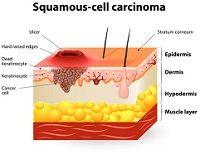Analysis: Skin Cancer Risks, Recurrence, Metastasis, and Death
Researchers reviewed all published data regarding the risk for recurrence, metastasis and disease specific death related to cutaneous squamous cell carcinoma (cSCC) and found that tumor depth and tumor diameter are important factors.

Researchers reviewed all published data regarding the risk for recurrence, metastasis and disease specific death related to cutaneous squamous cell carcinoma (cSCC) and found that tumor depth and tumor diameter are important factors. The review, published in the Journal of the American Medical Association Dermatology on January 13, 2016, was conducted by Agnieszka K. Thompson, MD, of the Department of Dermatology at the Mayo Clinic in Rochester, Minnesota, and colleagues.
There are approximately 700,000 cases of cSCC in the United States each year, and while most cases have an excellent prognosis following surgical removal, between “3.7% and 5.2% of patients have nodal metastasis, and 1.5% to 2.1% die of cSCC.” This review was undertaken to “quantify the magnitude of each risk factor and the quality of the supporting data.”
Studies included in the review had to have “at least 10 patients with cSCC that reported comparative data associating at least 1 defined risk factor” such as depth of invasion, tumor differentiation, immunosuppression, among others, as well as “an outcome of interest.” After applying multiple exclusion criteria, 36 studies were included in the review.
Those 36 studies described 23,421 cSCCs in 1,248 patients. None were randomized trials. The majority, 31, were retrospective studies, and the remaining 5 were prospective cohort studies. Regarding the risk of bias, the authors say, “six studies (16.7%) were deemed to have low risk of bias due to the presence of multivariable data, and the other 30 studies (83.3%) were of high or unclear risk owing to a lack of adjustment for confounding variables.”
The researchers found that tumor depth “was associated with the highest risk RR [risk ratio] of local recurrence.” Other factors that were associated with local recurrence were “tumor diameter, location on the temple, and poor differentiation.” They were surprised to find that “location on the lip or ear and immunosuppression were not associated with a statistically significant RR of local recurrence in the present meta-analysis.”
Metastasis is associated with poor outcomes and therefore is one of the most “well-studied and well-represented” factors related to cSCCs. The researchers found that “tumor depth was associated with the highest RR of metastasis” as they found when they looked at local recurrence. Tumor diameter and poor differentiation were also factors in metastasis.
Disease specific death was the least studied factor with data for analysis. Tumor diameter was the risk factor with the highest RR for disease specific death, but the researchers add, “this conclusion is based solely on one study.”